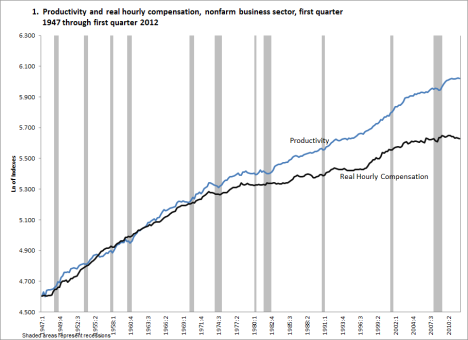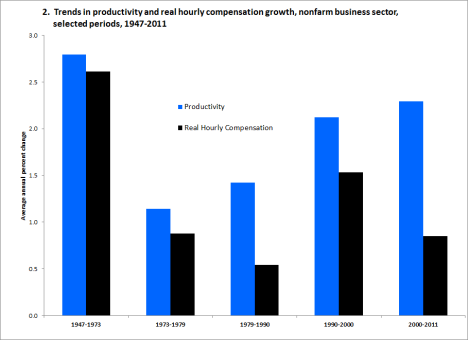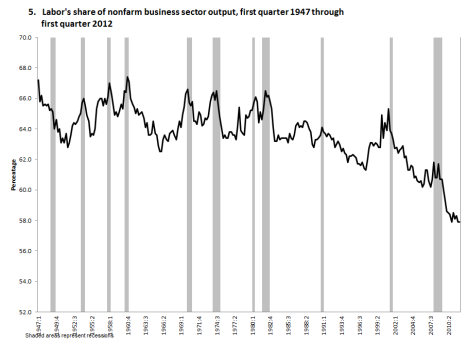In the late 1970s a gap opened up between the productivity of workers, and the amount they were being paid. The not-so-creative name for this trend is the wage-productivity gap. The causes are hotly debated, but the consequences are straightforward. The economy continues to grow through increases in productivity, but the benefits of increased productivity are not shared by workers. This means real wages stagnate, and inequality increases. It also calls into question the justice of a system in which the production of workers is divorced from the wages of workers. The Bureau of Labor Statistics has put together a visual essay on wage-productivity gap.
In chart 1 we see the rate of change in productivity growth compared to the rate of change in real (inflation-adjusted) hourly compensation (1). Chart 2 breaks down the trend by selected time periods. We can see that from 1947 to 1979, wages and productivity grew together. They started to separate in the 1970s, and came completely unglued in the 1980s, through the early 1990s. The late 1990s was the only time in the past 30 years that real (inflation-adjusted) wages grew with productivity, and then in the 2000s wages remained stagnant while productivity continued to increase.
The growing gap is also reflected in the decrease in labor’s share of output.
For a long time the labor share was thought to be constant. Here again, the causes are both complex and disputed, but the consequences are clear, less of the work being done by workers is reflected in their wages.
Without really figuring out what’s going on, it’s tough to reverse these trends. Chances are technology, globalization, and loss of union power all play roles in driving down labor’s share of income and opening up the wage-productivity gap. In some cases (technology and globalization) those processes have benefits as well as costs, so the trick is to capture the benefits while reducing or eliminating the costs. This is not an easy task, but there are a few clear implications to these trends.
First, we should support a strong safety net. Stagnant real wages and unemployment are being caused by macroeconomic changes, not individual’s suddenly becoming less productive or less deserving. Second, we can raise the minimum wage to help insure that workers share in the gains of productivity.
(1) Technical note: Taking the log of both indexes allows us to see the rate of change presented visually. Instead of each tick mark representing an increase of X in a meaningless index, each tick mark represents a percentage increase (in this case, each tick mark is a 22% increase). The gap actually looks much larger if you don’t log-transform the data first, as later changes are bigger in absolute terms than they are in percentage terms.
Filed under: Economics, Poverty, Poverty Trends and Research | Tagged: wage-productivity gap |





Reblogged this on Some Things Considered and commented:
From my work blog: